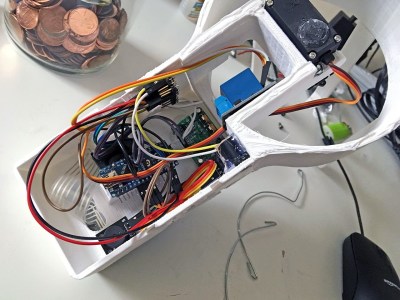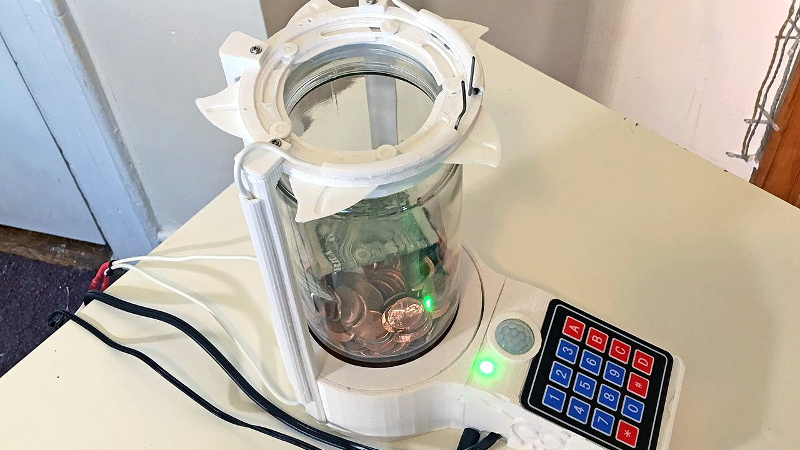How do you keep people out of your change jar? If you didn’t say with a 3D printed iris mechanism and high-voltage spark gap, then clearly you aren’t [Vije Miller]. Which is probably for the best, as we’re not sure we actually want to live in a world where there are two of these things.
Regular Hackaday readers will know that [Vije] has a way of using electromechanical trickery to inject a bit of excitement, and occasionally a little danger, into even the most mundane aspects of life. His latest project is an automated change jar that uses a pinpad to authenticate users, while everyone else gets the business end of a spark gap if the PIR sensor detects them getting to close.
 You can see a demonstration of the jar in the video after the break, where he shows the jar’s ability to stop…himself, from getting access to it. Hey, nobody said it was meant to keep out real intruders. Though we do think a similar gadget could be a fun way to keep the kids out of the cookie jar before dinner, though we’d strongly suggest deleting the high-voltage component from the project before deploying it with a gullet full of Keebler’s best.
You can see a demonstration of the jar in the video after the break, where he shows the jar’s ability to stop…himself, from getting access to it. Hey, nobody said it was meant to keep out real intruders. Though we do think a similar gadget could be a fun way to keep the kids out of the cookie jar before dinner, though we’d strongly suggest deleting the high-voltage component from the project before deploying it with a gullet full of Keebler’s best.
[Vije] was able to adapt a printable iris design he found on Thingiverse to fit over the mouth of the jar, and uses servos in the base to rotate the whole assembly around and open it up. The internal Arduino Nano handles reading from the pinpad, controlling the stepper, and of course firing up the spark generator for 1000 milliseconds each time the PIR sensor detects somebody trying to be cute. Just the sound of the arc should be enough to get somebody to reconsider the value of literal pocket change.
Some of the design elements used in this change jar’s high voltage components were influenced by the lessons learned when [Vije] was building his plasma-powered toilet air freshener. There’s a sentence we bet you never expected to read today.
















Awesome!
After mention of an iris mechanism for intruder protection, I was expecting razor edges…but that would present a testing problem…you’d only get 10 goes to perfect it!
I was expecting a wire through the bottom of the jar, putting the high-voltage directly on the metal coins, removing the need for any kind of lid.
That’s what I was thinking too. Although a security system that can be bypassed by turning it upside-down is less than desirable.
designed by masterlock
no, no, NO! You get this wrong, testing iris mechanism with razor edges should ALWAYS be done with winner sausages.
winner sausages…….What did they wien ?
Will it blend?
The weak part is all the extra wires going outside the contraption.
TBH the original sketch hid the wires neatly to prevent fiddling – then it went to sh\t when neglectfully re-cading/printing parts due to a temperamental faux Prusa printer. My work space is presently a 2’x4′ desk in the corner of a friend’s room so admittedly /corners/ get cut. If any one has a zeppelin sized warehouse to share – aye have another 127+ projects or so …
You realize that someone can cut the 2 pairs of wires – black and white wires and grab the whole darn thing and worry about it later. Your sketch won’t help in this case. Even if you have a battery inside, it will eventually runs out. Once the thief is at a safe location and then he/she can smash the jar or bend/cut the 3 support pillars to get at the jar.
The big question is why you leave a jar of goodies in the open in a location that it can be stolen.
Well see now you stepped over on to the taken too seriously side. It .. its a coin jar.
I want some of these for my car door handles – grab the handles while the car isn’t unlocked. bzz.
The obvious answer is to reach in, and watch it smash on the floor when the spark triggers the muscles in your arm. Then you can just pick the change out of the broken glass.
the only thing I wonder: what’s the artist and title of the song in the beginning? ¯\_(ツ)_/¯
https://www.youtube.com/watch?v=WY-iiZi1lFE
From my perspective this piece is beautifully crafted “desk art.” Criticizing the external wiring is like saying the Mona Lisa needs more cow bell.
– Thomas
You sir … you get it. +1
– William M. Buttlicker